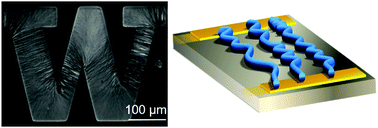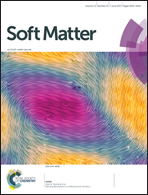Electric field directed formation of aligned conjugated polymer fibers†
Abstract
Alternating current (AC) electric fields effectively align poly(3-alkylthiophene) (P3AT) fibers during a one-dimensional crystallization process. Structural, mechanical and electrical properties have been probed using microscopy, small angle neutron scattering (SANS), atomic force microscopy (AFM), X-ray diffraction (XRD), rheology, UV-Vis spectroscopy, and dielectric spectroscopy. Optimum frequency and amplitudes were identified for specific P3AT concentrations and for variable solvent quality. Optical microscopy along with SANS and XRD demonstrate alignment persists over both micrometer and nanometer length scales. Small amplitude oscillatory shear rheology also showed that the shear modulus increased for aligned fibers. The structural changes were correlated to improvements in electric conductivity as probed by dielectric spectroscopy. XRD experiments performed with variable sample orientations also showed that the P3HT π–π stacking direction was aligned parallel to the direction of the fiber axis. Electric field alignment was also possible for other alkyl-thiophene polymers and for polymers with simple backbone repeat units.



 Please wait while we load your content...
Please wait while we load your content...